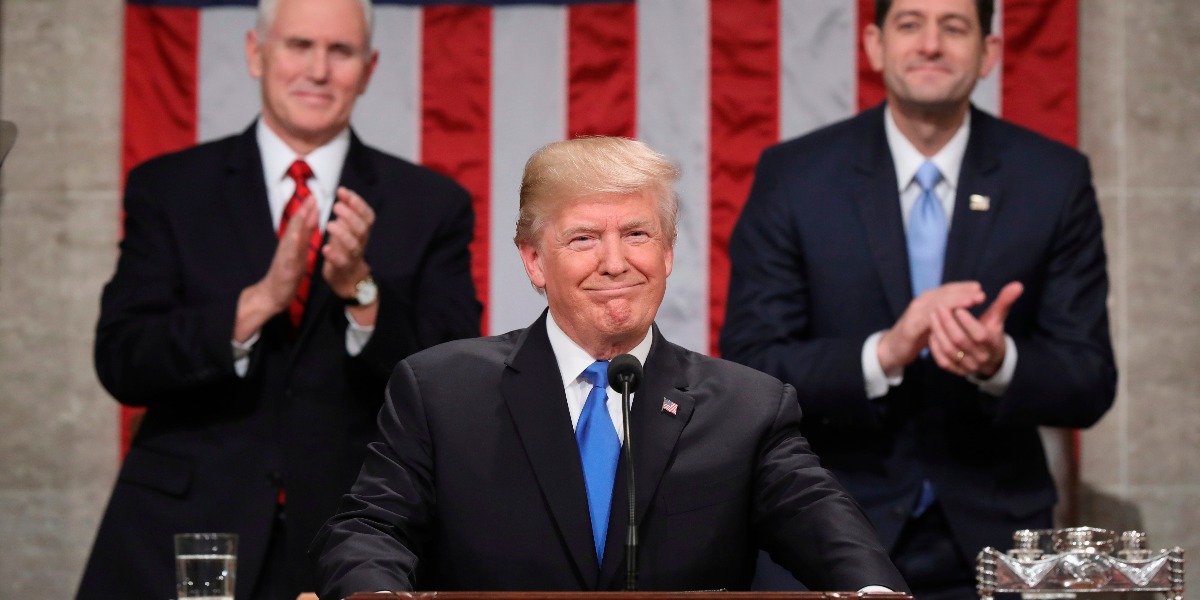The White House debuted its infrastructure proposal last week, outlining a plan to spend $200 billion in federal money over the next decade. President Trump took to Twitter to hype the plan’s release, and he chose to do so by contrasting this program with the reckless spending of the past 17 years of U.S. foreign policy. “This will be a big week for Infrastructure,” the president wrote. “After so stupidly spending $7 trillion in the Middle East, it is now time to start investing in OUR Country!”
Videos by Rare
https://twitter.com/realDonaldTrump/status/963031666150313984
Whether the infrastructure plan should or will work as Trump hopes remains to be seen, but the contrast he presented deserves attention now because the president denounced reckless military spending immediately after he demanded more of it, a contradiction that is emblematic of the Trump administration’s stagnant and confused first-year foreign policy record.
The tweet follows close on the heels of the congressional budget agreement that sets funding for the Pentagon’s staggering $700-billion budget for 2018. That includes a 15.5 percent bump over the previous year which comes at Trump’s insistence, and the Chicago Tribune reports it is the Defense Department’s “biggest year-over-year windfall since the budget soared by 26.6 percent” in 2002 — the first full year of the Mideast war spending Trump decried.
The $700-billion budget also includes $45 billion to be spent on the war in Afghanistan in 2018 alone, more than double the average of $20 billion for each year of the infrastructure proposal. As much as Trump speaks of shifting Washington’s priorities away from overseas adventures and toward the basics here at home, the numbers tell a different story.
The Afghanistan price tag could go higher still, for it fails to account for the administration’s plan to increase the number of U.S. boots on the ground — and that’s just one war, one of many. Meanwhile, Secretary of State Rex Tillerson has indicated American troops will stay in Syria indefinitely. We’ve learned the post-Islamic State drawdown of U.S. presence in Iraq will not be quick, total or permanent. And any number of unknown U.S. military interventions in the greater Mideast and Africa (remember the ambush in Niger?) will persist, their costs, purposes and consequences all mysterious to the American people. In short, the “stupid” spending Trump condemns continues apace under his own administration.
This is so despite Trump’s pattern of questioning the wisdom and value of the United States’ post-9/11 foreign policy. Monday’s tweet echoed, nearly word for word, a similar post Trump made in December, and the best of his election-era pronouncements on foreign affairs stemmed from his willingness to reexamine Washington orthodoxy after a decade and a half of war.
But Trump’s answers in governance have not matched his questions on the campaign trail. So far, he has not forged the “new era of peace, understanding and goodwill” he promised before taking office, nor has he “stop[ped] looking to topple regimes and overthrow governments” or “pursue[d] a new foreign policy that finally learns from the mistakes of the past.” As a Chatham House analysis of Trump’s take on defense observed, “one can find in it elements of isolationism, realism and interventionism, sometimes even in the same statement.”
Thus, instead of leading Washington on a new path that moves away from stupid spending, from trying to impose an external American military solution on the internal political problems of other nations around the world, Trump has fallen into Washington’s familiar groove of intervention and occupation without concern for cost or consequence — or benefit to U.S. taxpayers and citizens. Despite his own critique of the impulse to “send troops everywhere,” regardless of any clear connection to vital U.S. interests or a viable path to conclusion, Trump has largely continued the foreign policy of his post-Cold War predecessors. The American people have continued to foot the bill.
The president’s $7 trillion figure wasn’t exactly accurate. As a Washington Post fact-checker noted, most estimates put actual outlays in Iraq and Afghanistan somewhere around $2 trillion, while the total taxpayer obligation when we account for related expenses like veterans’ medical costs could total $4 to $6 trillion, according to a Harvard University faculty working paper.
But Trump undercounted, too, if a 2016 calculation of long-term costs (most significantly, interest on war debt) is correct. Per that analysis from Brown University, interest payments alone will total nearly $8 trillion by 2053, bringing the cost of U.S. interventions in Afghanistan, Iraq, Pakistan and Syria above the $12 trillion mark — and that’s if our military operations in all four nations had ended in December.
They did not, so “stupidly spending in the Middle East” has not ended either.
RARE POV: Washington says the war in Iraq is ending — again — but it’s probably not



